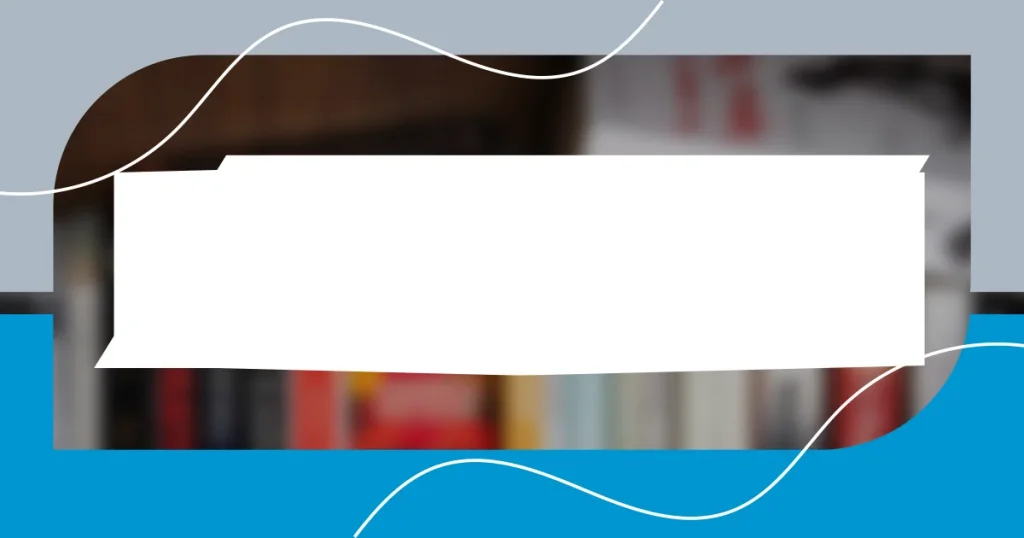Key takeaways:
- The romantic genre is defined by conventions such as “happy endings,” emotional intensity, and character growth, which resonate with real-life relationships.
- Key themes in romance include forbidden love, self-discovery, and second chances, providing emotional depth and relatability in storytelling.
- Evolving trends highlight increasing diversity in character portrayals, unconventional story resolutions, and the impact of technology on modern romantic narratives.

Understanding romantic genre conventions
The romantic genre is rife with conventions that create expectations. Think about the subtle thrill of a chance encounter or the tension that builds from a love triangle. Personally, I’ve found that these elements echo real-life dynamics, triggering my emotions and making me reflect on my own relationships.
One noteworthy convention is the “happy ending” trope. While it offers a sense of closure, it can sometimes feel unrealistic. I often wonder, do we really need everything to wrap up perfectly? In my experience, life’s messy and unpredictable, and that’s where the beauty of romance lies—navigating the imperfections together.
Another fascinating aspect is the emotional intensity that characters often experience. These heightened emotions can feel overwhelming yet cathartic. It reminds me of the giddy butterflies I felt during my first crush. Isn’t it captivating how a well-crafted romantic story can transport us back to those feelings, allowing us to relive that rush? Through these conventions, we not only find entertainment but also a lens through which we can examine our desires and relationships.

Key elements of romantic stories
There are several key elements that define romantic stories, and I’ll share a few that I believe contribute significantly to their appeal. For me, the journey of two individuals navigating their feelings is an adventure of its own. When I think about my favorite romantic tales, I often find that they include:
- Chemistry between characters: That spark has to be palpable. I remember feeling a rush of excitement when watching two characters exchange glances that spoke volumes. It’s those moments that make my heart race.
- Conflict or obstacle: Whether it’s a misunderstanding or external circumstances, something must stand in the way of love. I recall a movie where the lovers faced societal pressures. Their struggle drew me in, making their eventual union feel like a hard-earned victory.
- Character growth: Watching characters evolve as they confront their vulnerabilities gives depth to the romance. It reminds me of my own journey through relationships, where growth often came from facing fears head-on.
These elements aren’t just ingredients for a good romance; they create a tapestry of emotions that resonates deeply with us. Each story becomes a reflection of our own experiences and emotional journeys.

Common themes in romance novels
Common themes in romance novels can evoke a range of emotions and resonate with readers on multiple levels. One prevalent theme is the idea of forbidden love. This often brings to mind my own youthful crushes, where societal norms or family expectations complicated my feelings. Remembering those days, there’s something thrilling about a love that feels unattainable; it makes the chase all the more exhilarating.
Another theme that continuously captivates me is self-discovery through love. Characters often embark on a journey not just towards each other, but towards understanding themselves. When I think about the lessons I learned in past relationships, I realize how they shaped my identity and values. It’s fascinating how romance can serve as a backdrop for personal growth, allowing characters and readers alike to reflect on their own lives.
Finally, the theme of second chances can be particularly heartwarming. It’s reminiscent of my experience with rekindling an old friendship that was lost due to misunderstandings. The vulnerability of confronting the past can be profoundly emotional; after all, who doesn’t long for the opportunity to reclaim a connection? It’s this blend of themes that makes romance novels so engaging and relatable, reflecting the myriad complexities of love.
| Theme | Description |
|---|---|
| Forbidden Love | A love marked by societal or personal obstacles that heightens the sense of longing and excitement. |
| Self-Discovery | Characters grow and learn about themselves through their romantic relationships, leading to personal development. |
| Second Chances | The emotional journey of rekindling old relationships or repairing past mistakes, emphasizing redemption and vulnerability. |

Character archetypes in romance
When I think about character archetypes in romance, a few stand out for their relatability and depth. The alpha hero often grabs attention with his confidence and charm, but I can’t help but appreciate the beta male or the quiet, sensitive type who brings a refreshing vulnerability to love stories. I’ve noticed that the contrast between these archetypes generates such rich dynamics—who doesn’t enjoy a good clash between strength and emotional openness?
Then there’s the quirky best friend—everyone knows this character, right? I remember a time when my own best friend played that role in my life, providing comic relief and wise insights when I was overwhelmed by crushes. This archetype often serves to highlight the protagonist’s journey, leading them to moments of self-reflection. Isn’t it fascinating how someone outside the romantic spotlight can help reveal the true nature of love?
Let’s not overlook the will-they-won’t-they couple. The tension between them often creates some of the most gripping narratives. I recall binge-watching a show where the chemistry was palpable, leaving me on the edge of my seat episode after episode. Those drawn-out moments of connection paired with miscommunication can drive the story forward, forcing both characters to confront their true feelings. It’s in these archetypes that we find our own experiences mirrored, making the romance feel all the more authentic.

Structure of romantic plots
The structure of romantic plots typically follows a familiar arc, often hinging on the conflict that arises between characters. I’ve noticed that this tension is essential; it propels the narrative forward. For instance, whether it’s a misunderstanding or external forces driving them apart, these hurdles amplify the stakes. It reminds me of those moments when I faced challenges that seemingly kept me from being with someone I liked. Isn’t it intriguing how obstacles can enhance emotional investment in a story?
What often fascinates me is the transformative journey that both partners undergo. In many romantic plots, characters enter their relationships with distinct flaws or insecurities, only to emerge as stronger individuals. This resonates deeply with my own experiences, especially when I think of moments where love pushed me to confront my vulnerabilities. Have you ever felt this kind of growth from a relationship? It’s a beautiful reminder that love can be a catalyst for personal change.
Of course, romance narratives usually culminate in a resolution that feels satisfying—whether through an emotional reunion or a bittersweet parting. I sometimes wonder how many of us secretly crave that perfect ending in our lives, mirroring those storybook conclusions. I recall a particular movie where the lovers faced insurmountable odds but found their way back to each other in a heartwarming twist. Those moments create a sense of hope and affirmation, proving that love, despite its challenges, can triumph in the end.

Importance of setting in romance
Setting plays a crucial role in romance, establishing the mood and influencing character interactions. For example, a cozy café bustling with life can create an atmosphere of serendipity, where two potential lovers might just bump into each other. I remember a time when I met someone special at my favorite coffee shop, and the vibrant energy around us turned an ordinary day into something magical; it’s moments like that where setting becomes a character in its own right.
Moreover, the geographic backdrop often reflects the emotional landscape of the characters. A story set in a sun-soaked beach paradise can evoke feelings of bliss and freedom, while a rainy, shadowy city might symbolize emotional turmoil and tension. I had a relationship flourish during a summer trip to a charming coastal town, where the setting not only heightened the romance but also served as a reminder of how environments can influence our connections. Does the setting not serve to amplify our feelings in ways we sometimes overlook?
Finally, incorporating cultural and historical elements in romance settings can deepen the narrative, providing a layer of richness to the characters’ journeys. When I read a romance set amidst the backdrop of a festival steeped in traditions, it brings the characters’ emotions to life in a vibrant tableau. I’ve found myself captivated by how these elements can serve as catalysts for conflict or connection. Have you ever noticed how the right setting can make a story resonate more deeply? It’s fascinating how a well-crafted environment can draw us in and make love stories feel not just important but memorable.

Evolving trends in romantic fiction
Evolving trends in romantic fiction reveal a shift toward more diverse and complex portrayals of love. Recently, I’ve noticed how stories increasingly include LGBTQ+ relationships and culturally diverse characters, allowing a broader audience to find themselves in the narratives. This shift resonates with my understanding that love transcends traditional boundaries; doesn’t it feel empowering when everyone’s story is told?
Additionally, there’s been a rise in unconventional endings and story resolutions that deviate from the classic “happily ever after.” I find this refreshing, as it reflects real-life relationships where outcomes can be messy and nuanced. It reminds me of my own experiences, where not every romantic endeavor led to a perfect conclusion but taught me invaluable lessons. Have you ever celebrated a love story that didn’t tie up neatly, yet still felt deeply fulfilling?
Moreover, the integration of technology into romantic narratives has transformed how characters connect. I can’t help but recall my own adventures with online dating, where swiping left or right became part of my routine. The way these platforms have redefined love is fascinating; it raises the question—does technology enhance our relationships, or does it complicate them? Exploring this dynamic in stories adds a layer of relatability that genuinely reflects modern romance.
















